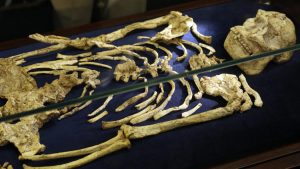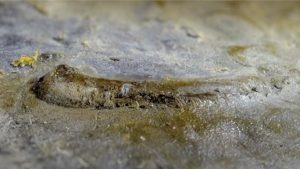I know, I just wrote a post about paleontology a little more than a week ago (29Nov17) but there have been several interesting announcements including a big one that’s been 20 years in the making. I’ll start with the announcement that those of us who keep up to date on fossil news have been waiting for so long.
The nation of South Africa has for almost a century now been a rich source for fossils related to the evolution of our own species Homo sapiens. In particular explorers have made many important discoveries while searching the limestone caves in the northern part of the country.
In July of 1997, Professor Ron Clarke of the University of Witwatersrand in South Africa was exploring a cave about 40km northwest of Johannesburg from which he and his assistants had already discovered several foot bones along with leg bone fragments.
What they found was the almost complete skeleton of an Australopithecus female, aged about 30.The remains were named ‘Little Foot’ because of the foot bones Clarke had found earlier. Clarke speculates that the young female fell to her death in the cave approximately 3.67 million years ago.
Problem was that over the centuries dirt and other debris also fell into the cave encasing the fragile bones in hard rock that had to be removed VERY carefully so as not to damage the fossil. So Professor Clarke and the other paleontologists at Witwatersrand took their time, 20 years in fact and just this week the fully prepared skeleton was displayed to the public for the first time. The images below show Professor Clarke with “Little Foot’ along with a close-up of the skull and upper body.


How much ‘Little Foot’s’ remains will add to our knowledge of human evolution remains to be seen. The theoreticians are going to have to think about it for awhile but ‘Little Foot’ represents an enormous amount of data. And remember no one knows what else is waiting to be found in those caves in South Africa. I expect to hear about a lot more discoveries in the next few years.
A somewhat older fossil find, about 530 million years older, comes from Estonia and gives us our earliest evidence for the evolution of an eye. Now, not a refractive cornea type of eye such as humans and other vertebrates possess but rather a compound eye of the type that lobsters, crabs and insects use.
The evidence comes from a specimen of one of my favourite types of extinct animals, a trilobite. The fossil in question, see image below, has been analyzed by Professor Euan Clarkson of Edinburgh University. The pictures below show the entire fossil from above alone with a side view of one of the compound eyes.


According to Professor Clarkson the eye is remarkably modern, the only noticeable difference is the lack of a lens like structure. Although the animal probably had poor vision compared to modern insects or crabs it nevertheless could detect predators and obstacles.
My final fossil discovery for today lived during the Triassic period, about 245 million years ago, but concerns the line of animals that are the closest living relatives of the Trilobites, the Horseshoe Crabs.
A new fossil species of horseshoe crab has been discovered in the state of Idaho by a team of paleontologists led by Allen J Lerner of the New Mexico Museum of Natural History and Science. The shape of the animal’s shell, see image below, reminded the discoverers of the helmet of the famous villain Darth Vader from the ‘Star Wars’ series of movies so they decided to name their find Vaderlimulus.

Now Vaderlimulus is an important find, being the first known fossil horseshoe crab from the Triassic in North America but let’s be honest, it’s that name that got it publicity.
